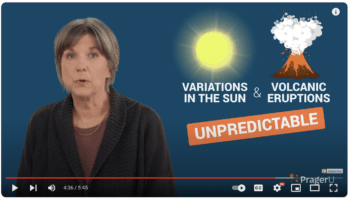- Climate
Popular story on Fox2Now accurately describes 2017 global temperature, sea ice extent
Reviewed content

Headline: "NASA releases time-lapse of the disappearing Arctic polar ice cap"
Published in CNN, Fox News, by Brandon Miller, on 2018-02-26.

Scientists’ Feedback
SUMMARY
This February 2018 article on the website of Fox 2 St. Louis—based on an article syndicated from CNN—reported on 2017 climate data released by NOAA and NASA. It notes that 2017 ranked as the second/third (depending on dataset) warmest year on record, and annually averaged sea ice extent in the Arctic was at its second lowest extent.
Scientists who reviewed the article found that it accurately conveyed this information. However, a couple statements lack clarifying details. It is not explained that the sea ice extent numbers given relate to annual mean extent rather than summer minimum extent, for example, or that temperature was given relative to the 1951-1980 average.
This is part of a series of reviews of 2018’s most popular climate stories on social media. This article has been shared more than 1.1 million times on social media as of writing, making it the most popular story of 2018 so far.
See all the scientists’ annotations in context. You can also install the Hypothesis browser extension to read the scientists’ annotations in context.
REVIEWERS’ OVERALL FEEDBACK
These comments are the overall assessment of scientists on the article, they are substantiated by their knowledge in the field and by the content of the analysis in the annotations on the article.

Professor, University of Reading and UK National Centre for Earth Observation
The NASA movie [below] shows the power of being able to visualise what has been happening to the environment over many years, in this case for Arctic sea ice. The evidence of change is plain to see. The facts-driven description in the article that accompanies the movie addresses developments in other parts of Earth’s climate system straightforwardly and informatively.

Postdoctoral Research Fellow, Université catholique de Louvain
The article is factually correct. The reality that Arctic sea ice is getting younger [rather than surviving for several years and growing thicker] is not so well known from the public, so such an article is welcome.
The article’s title and the front video are about sea ice, but most of the rest of the text is about global temperatures. There has been clear evidence that the two (rising temperatures and declining sea ice) are linked on long time scales (say, >15 yr), but interannual fluctuations of the latter are more difficult to formally relate to the former.

Research Scientist, Lawrence Livermore National Laboratory
Overall, I thought the article provided a good summary of the major climate features of 2017. The article mentioned a number of geophysical metrics, including sea ice, temperature, extreme events, and snow cover. The article had a good discussion of the impact of natural El Niño/La Niña variability (despite a slightly inaccurate description of El Niño/La Niña), noting that 2017 was the hottest year on record if El Niño/La Niña events are statistically removed. The article also included a brief, but warranted discussion of the Paris Climate Agreement.

Polar Climate Scientist, British Antarctic Survey
The article is credible and the overall message/insight conveyed to the reader is accurate.
However, the reader could be easily misled on some details because some of the values quoted are given with insufficient information and without traceable sources. (The 2017 temperature anomaly quoted is relative to 1951-1980. The Arctic sea ice ‘second lowest’ refers to the annual mean.)
Notes:
[1] See the rating guidelines used for article evaluations.
[2] Each evaluation is independent. Scientists’ comments are all published at the same time.
Annotations
The statements quoted below are from the article; comments are from the reviewers (and are lightly edited for clarity).
According to NASA, the globally averaged temperature of the land and ocean was 0.9˚C (1.62˚F) above the 20th century average. This puts us well over halfway to the ambitious target of limiting warming to 1.5˚ C (2.7˚F) set in the 2016 Paris Climate Agreement.

Polar Climate Scientist, British Antarctic Survey
The source for this information is here. 2017 was 0.9°C warmer than 1951-1980. The Paris agreement target was “[to keep] the global temperature rise this century well below 2 degrees Celsius above pre-industrial levels and to pursue efforts to limit the temperature increase even further to 1.5 degrees Celsius.
Pre-industrial is an earlier period than 1950-1981, so “well over halfway… to 1.5°C” is therefore still true. Therefore the spirit of the statement in these sentences is true although the details are slightly inaccurate.

Research Scientist, Lawrence Livermore National Laboratory
I think 2017 was compared to the 1951-1980 average.
Note that the Paris target is “to limit the temperature increase to 1.5°C above pre-industrial levels” and the 0.9°C value is relative to 1951 – 1980.
El Niño is characterized by a warming of the surface waters in the tropical Pacific Ocean

Research Scientist, Lawrence Livermore National Laboratory
This should be “in the central and eastern-central equatorial Pacific”.
La Niñas, on the other hand, feature cooler than average waters in the Pacific

Research Scientist, Lawrence Livermore National Laboratory
This should be “in the eastern equatorial Pacific”.
Sea ice continued its declining trend, both in the Arctic and Antarctic.

Polar Climate Scientist, British Antarctic Survey
It is misleading to already call the recent turn in Antarctic sea ice a declining trend. “Trend” suggests something happening long-term; as stated in the next sentence, the Antarctic downturn is recent.
The Antarctic, which was trending at record high levels just a few years ago, reached a record low during 2017

Polar Climate Scientist, British Antarctic Survey
Both in the annual-mean and for the minimum extent and other summer months. (See NOAA’s summary.)
In the Arctic, sea ice extent was the second-lowest since records began in 1979, behind only 2016,

Polar Climate Scientist, British Antarctic Survey
This is true for the annual average; for the September minimum extent, which is often discussed, the minimum was 2012.



